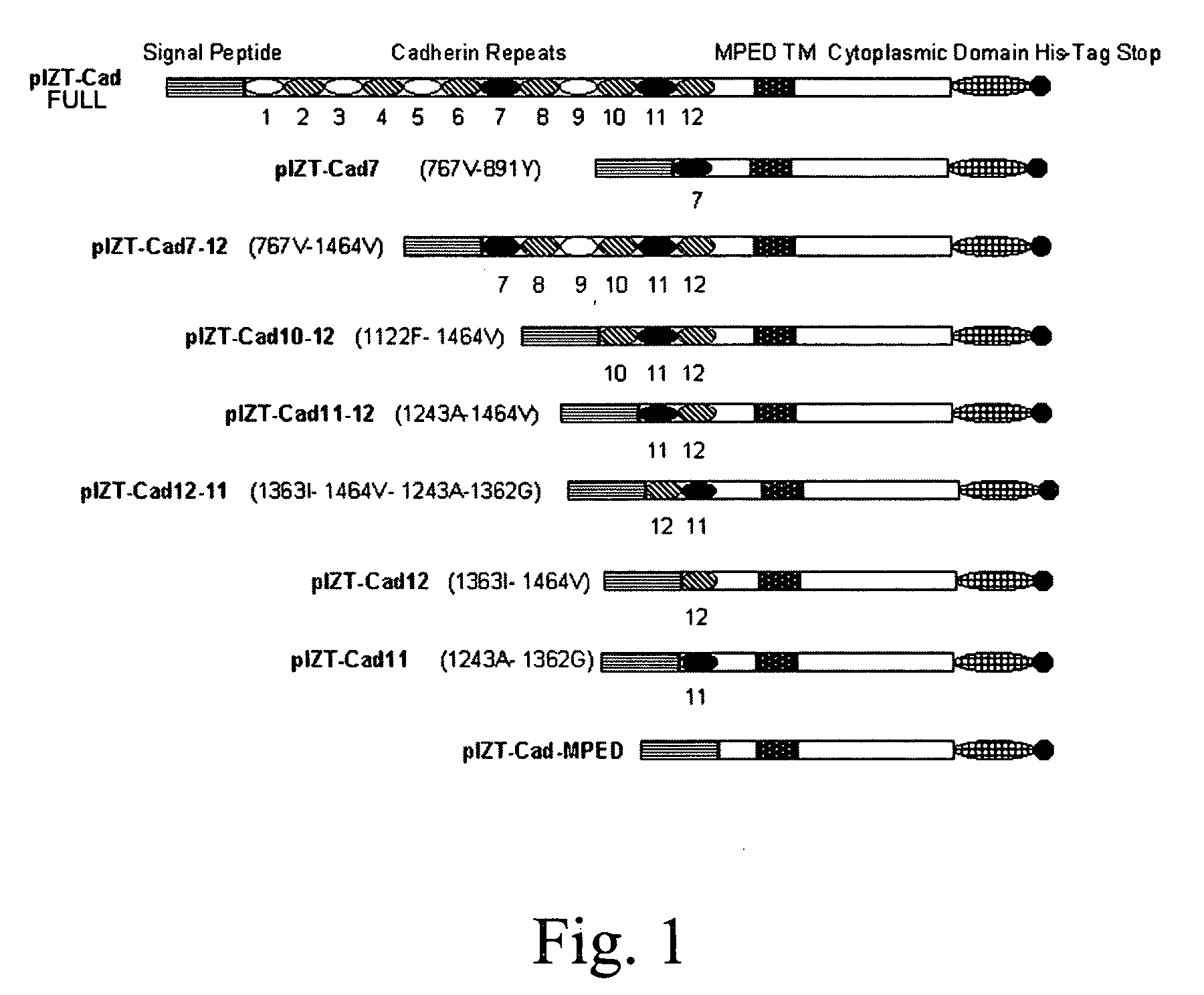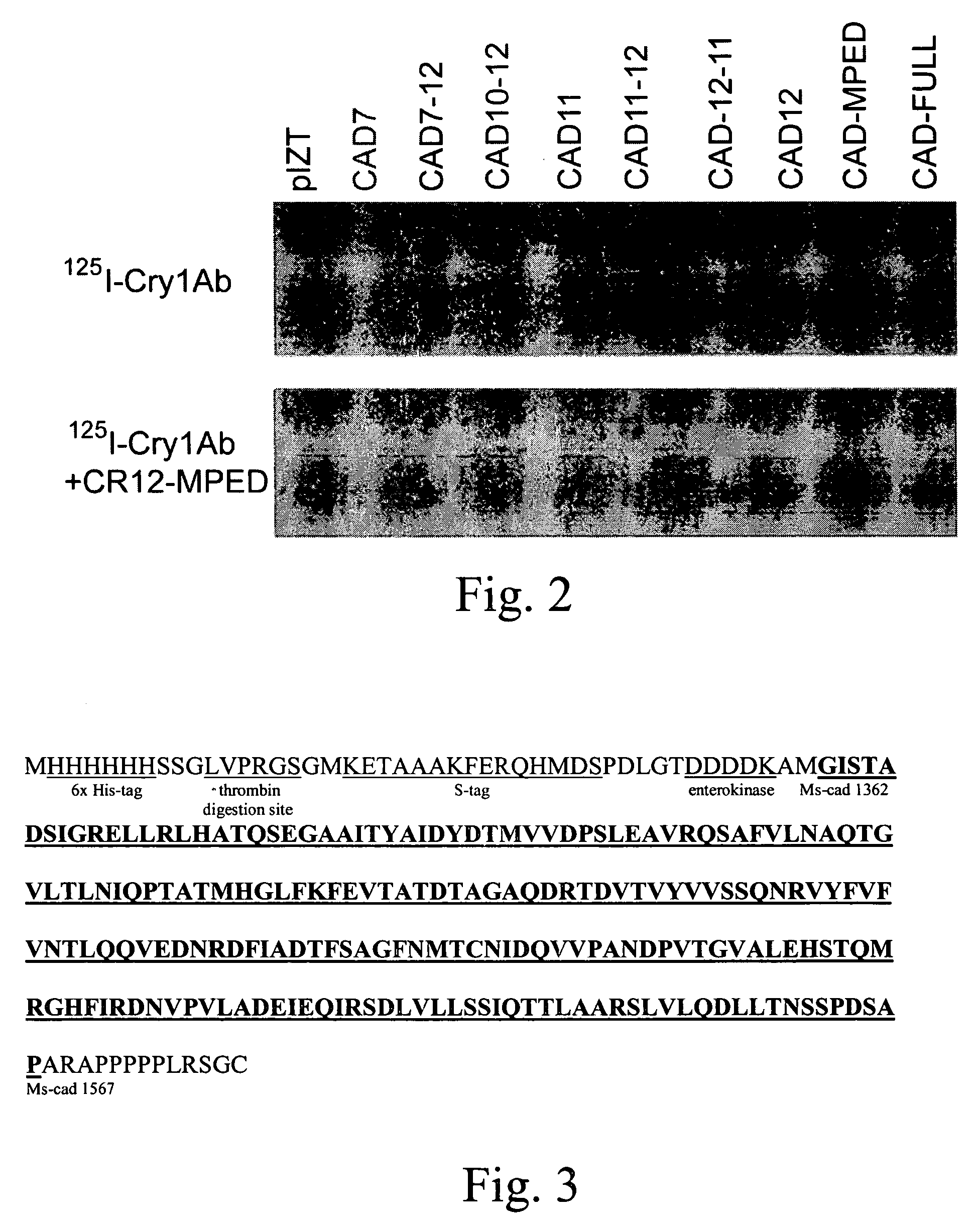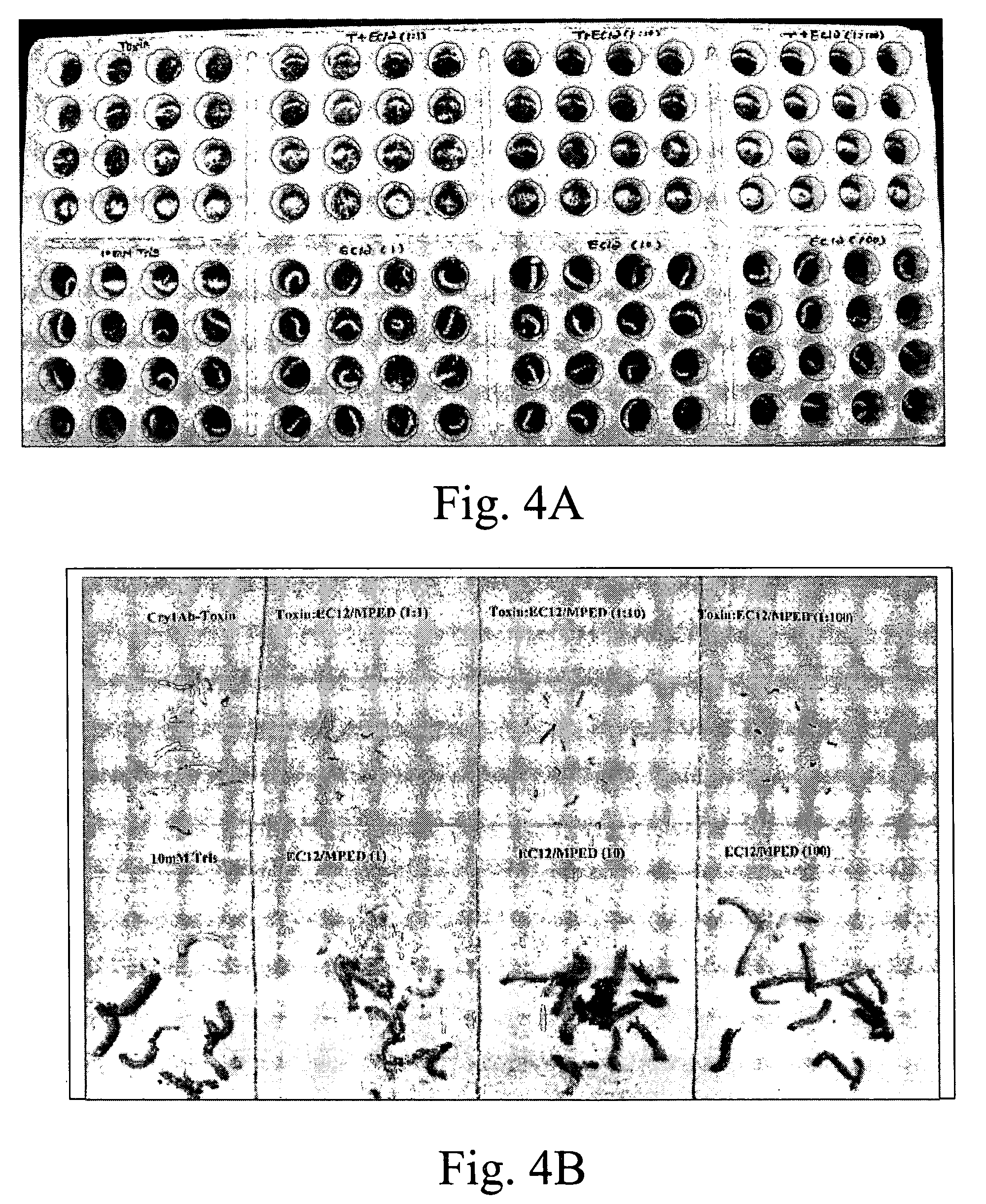Peptides for inhibiting insects
a technology of insect and peptide, which is applied in the direction of peptide/protein ingredients, peptide sources, applications, etc., can solve the problems of many concerns and regulatory restrictions, inability to teach or suggest the administration of cadherin-like protein fragments, and inability to inhibit insect growth, so as to enhance the apparent toxin activity of cry proteins
- Summary
- Abstract
- Description
- Claims
- Application Information
AI Technical Summary
Benefits of technology
Problems solved by technology
Method used
Image
Examples
example 1
Summary of Antagonistic Binding and Toxicity Blocking Assays
[0125] Previously, toxin binding regions on Bt-R1 were shown to act as antagonists to Cry1Ab by blocking toxicity (Dorsch et al. 2002; Gomez et al. 2001, Gomez et al. 2003). The CR12-MPED region encoded by the region of Bt-R1a including cad 12 and the MPED was tested using similar experiments. The CR12-MPED region (SEQ ID NO:2, encoded by SEQ ID NO:1) was over-expressed in E. coli and purified. Peptide was mixed with a LC50 dosage of Cry1Ab and fed to M. sexta larvae. Cry1Ab toxin was obtained by trypsin activation of the protoxin (Accession Number AAA22330). CR12-MPED was expected to block toxicity when mixed with Cry1Ab toxin and fed to larvae. The bioassay results were quite surprising. The CR12-MPED peptide did not suppress Cry1Ab toxicity but very surprisingly increased the mortality of Manduca larvae fed Cry1Ab. Increased concentrations of CR12-MPED mixed with a constant amount of Cry1Ab fed to the larvae killed more...
example 2
M. sexta Bioassay Trial 1
[0126]“group1”—9 ng / cm2 Cry1Ab (toxin:peptide ratio 1:0),
[0127]“group2”—9 ng / cm2 Cry1Ab plus 9 ng / cm2 CR12-MPED (ratio 1:1),
[0128]“group3”—9 ng / cm2 Cry1Ab plus 90 ng / cm2 CR12-MPED (ratio 1:10),
[0129]“group4”—9 ng / cm2 Cry1Ab plus 450 ng / cm2 CR12-MPED (ratio 1:50),
[0130]“group5”—9 ng / cm2 Cry1Ab plus 900 ng / cm2 CR12-MPED (ratio 1:100),
[0131]“group6”—9 ng / cm2 Cry1Ab plus 4500 ng / cm2 CR12-MPED (ratio 1:500)
[0132]“group7”—water only as a control.
[0133] Each group had 16 replicates.
[0134] After 7 days, many larvae in groups 4 and 5 were dead. This was attributed to the possibility that the Tris-HCl buffer, as the CR12-MPED peptide was in 10 mM Tris-HCl (pH 8.0). Alternatively, the CR12-MPED peptide could have been enhancing the toxicity of Cry1Ab. To determine if the high toxicity of the Cry1Ab / CR12-MPED mixture was reproducible, the bioassay experiment was repeated with additional controls.
example 3
M. sexta Bioassay Trial 2
[0135] A 1:500 ratio group (i.e., group 6 above) was not included because the 1:50 and 1:100 ratios gave an enhanced effect. Four additional controls were included: 10 mM Tris-HCl (pH 8.0), 9 ng / cm2 CR12-MPED, 90 ng / cm2 CR12-MPED, and 900 ng / cm2 CR12-MPED. In two days, almost all of the larvae in highest concentration of CR12-MPED / Cry1Ab were dead, but the larvae fed with the toxin-only were not dead. The CR12-MPED / Cry1Ab treatment groups showed the same trend as obtained in the first trial. Table 2 shows the percentage mortality for the treatments in both M. sexta trials. CR12-MPED enhanced the potency of B.t. Cry1Ab in both trials. FIGS. 4A and 4B show live and dead larvae from Trial 2. Notice the reduced size of larvae in the all groups fed with combinations of Cry1Ab plus CR12-MPED.
TABLE 2Bioassay results for Cry1Ab with CR12-MPED to M. sexta larvae. 9 ng9 ng9 ng9 ng9 ng1Ab / cm2 +1Ab / cm2 +1Ab / cm2 +1Ab / cm2 +1Ab / cm2 +9 ng90 ng450 ng900 ng4500 ng9 ng / cm2C...
PUM
| Property | Measurement | Unit |
|---|---|---|
| Fraction | aaaaa | aaaaa |
| Mass | aaaaa | aaaaa |
| Mass | aaaaa | aaaaa |
Abstract
Description
Claims
Application Information
 Login to View More
Login to View More - R&D
- Intellectual Property
- Life Sciences
- Materials
- Tech Scout
- Unparalleled Data Quality
- Higher Quality Content
- 60% Fewer Hallucinations
Browse by: Latest US Patents, China's latest patents, Technical Efficacy Thesaurus, Application Domain, Technology Topic, Popular Technical Reports.
© 2025 PatSnap. All rights reserved.Legal|Privacy policy|Modern Slavery Act Transparency Statement|Sitemap|About US| Contact US: help@patsnap.com



